InFocus X10 DLP Projector Review
InFocus X10 DLP Projector
InFocus' Full HD X10 is, quite simply, one of the most aggressively priced DLP projectors on the market, and it performs well too!
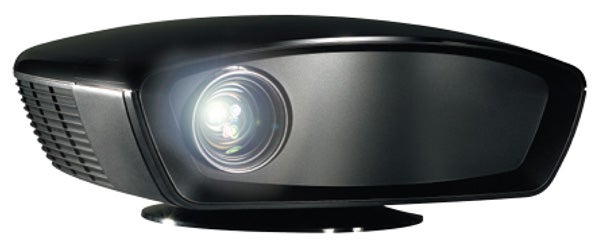
Verdict
Key Specifications
- Review Price: £898.99
Once in a while a product comes out of nowhere and blows out of the water any preconceptions we might have of the AV market. Cue the InFocus X10 projector…
This is a pretty bold start to a review, I guess. But I promise I’m not being sensationalist just to keep you reading. The X10 really does rewrite the rulebook, completely shifting our established frame of reference when it comes to evaluating other projectors in the future.
The key to our excitement about the X10 lies in the following, simple facts: it’s a Full HD DLP projector selling for under £900.
This totally demolishes the previous lowest price point of any other Full HD DLP projector we’ve seen; even Optoma’s ‘cheapo’ HD80 still costs you around £1,750 new.
Our searches did uncover another Optoma DLP model, the 8000X, going for around £1,000 – but we’ve seen absolutely zero marketing for this product, and it also seems to be available through extremely limited distribution channels. So it hardly seems poised to make the same sort of waves we’re predicting the X10 will. Having said that, rest assured we’re already doing our best to get hold of an 8000X for review.
Anyway, getting back to the X10, its price also seriously upsets the Full HD LCD applecart. For instance, we struggled to find Panasonic’s good Full HD PT-AE2000 or Epson’s disappointing Full HD EMP-TW1000 going for less than £1900 as we put this article together.
In fact, from what I can gather from InFocus representatives, one of the reasons InFocus has been so aggressive with the X10’s pricing is that it really wants the model to boot LCD out of the home cinema projector market altogether.
But you know, it’s hard to resist the thought that its price is so low it might be in danger of making it tough for any projector maker – including InFocus itself! – to make any sort of margins going forward. Time will tell, I guess.
Still, in the short term at least these sorts of concerns aren’t really our problem as punters at all. In fact, such price-slashing madness is amazingly good news for the reams of people out there who’d love to indulge in home cinema in its most large-scale form but never thought they’d be able to afford the necessary high-spec projector.
And believe us, the X10 really is high spec, despite its lowly price. For starters, as well as that key Full HD pixel count, it’s got all the connections you’d expect of a projector costing many times more, including two Deep Color-compatible v1.3 digital inputs (one HDMI, and one all-purpose M1-DA input for which the necessary HDMI adaptor is provided).
The X10 also claims a very respectable 2,500:1 ‘native’ contrast ratio – as in, a contrast ratio which, unlike the figures quoted by most LCD projectors, does not depend on a brightness-reducing dynamic iris system to achieve its full extent.
Even better, though, the X10 does have OPTIONAL manual iris adjustment that you can select from its onscreen menus, complete with various settings. With this you can expand the projector’s claimed contrast ratio to 7,500:1 – a really outstanding figure for the sub-£1k market.
Also rather remarkable for the X10’s price is its claimed maximum brightness of 1,200 ANSI Lumens, making it bright enough to deliver the key ‘D65′ colour standard calculated to produce the most natural results when watching video footage.
There’s a much wider selection of video adjustments at your disposal with the X10 than you might expect too, including multiple gamma presets; optional overscan removal (an essential item on a Full HD projector); colour space, temperature, gamut and control tweaks; a flesh-tone adjustment; the software part of Texas Instruments’ BrilliantColor system; and even, incredibly, all the facilities you need to have the projector professionally calibrated to suit your particular living room conditions by a certified Imaging Science Foundation engineer. This latter feature was once deemed as a premium trick for only the most discerning of buyers. Not any more, it would seem.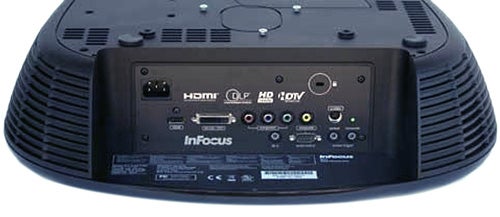
So far the X10 has done nothing but massively surpass the expectations raised by its price point. And for the most part this continues into its ease of use, too.
To help you set it up, for instance, its unusually large, matt black body is positioned on a swivelling, tilting foot mount, making it a doddle to get the image in the right place on your screen. Further assistance comes from digital vertical image shifting and keystone correction, and there’s a passable amount of optical zoom, too. Though I do have a bit of a gripe here, for oddly the lens is a slightly long-throw affair, meaning it requires quite a large room to deliver a really big picture – not, perhaps, an ideal situation for a budget model.
Before we get into seeing how the X10 delivers on its seemingly remarkable specification level, it does have one potential Achilles’ Heel lurking among all the facts and figures: a DarkChip 1 (DC1) DLP chipset.
In case you’re not familiar with the DarkChip story, some of the very latest projectors, including InFocus’s own IN83, are starting to use DarkChip4 technology, and we’ve been through DarkChip2 and Darkchip 3 along the way. So you can get a sense of how relatively ‘over the hill’ the X10’s core DLP engine is, at least on paper.
Which just goes to show how pointless it is to judge something ‘on paper’. For in reality, the X10 doesn’t perform like a DC1 projector at all. In fact, remarkably, its pictures have more in common with a few DC3 models we’ve seen.
For starters, the X10’s picture is almost unbelievably sharp. While watching the nice-picture-shame-about-the-movie Blu-ray of ”National Treasure 2”, the definition in the actors’ faces during the bright White House egg hunt sequence is little short of jaw-dropping. There’s exceptional fine detailing, total crispness, and a complete absence of video noise. What’s more, the outstanding detail levels also help generate a terrific sense of depth to the image, revealing every last subtlety of focus as the image trails into the distance.
Actually, the detailing here is so cute that it slightly reveals the shots of the White House for what they actually are: a special effects addition achieved through the miracle of blue-screen…
I’d really doubted that a projector as cheap as this one could deliver the full benefit a 1,920 x 1,080 pixel count can bring to an HD movie. But as well as the detail and lack of noise already noted, I was also struck by the purity of colour blends, as the X10’s extra pixel density does away with the vast majority of the ‘colour banding’ problem that can afflict budget projectors.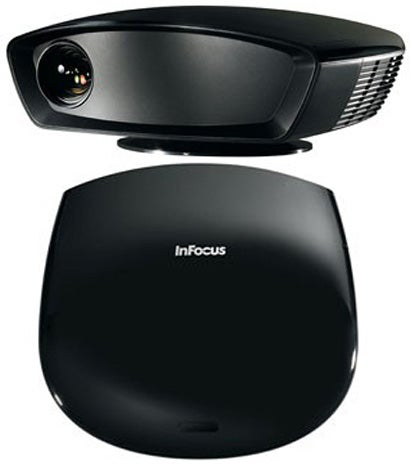
Also nothing short of remarkable is how bright the picture looks. DLP projectors at the X10’s sort of price point traditionally struggle to give images any real dynamism, but there’s dynamism aplenty on show here, even during the dark scenes that make up ”National Treasure 2’s” final half hour in the Olmec caverns.
Of course, brightness alone does not a great video picture make. But don’t worry; while the best picture quality on the X10 is achieved with the iris slightly closed (I personally set it to between 64 and 73), the resulting loss of brightness isn’t at all severe in the context of the benefits you reap in terms of black level improvement.
With the iris slightly closed the black levels you can achieve are simply in a different world to anything – repeat, ANYTHING – else we’ve seen anywhere at anything like the X10’s price.
And still we’re not even close to being done with the good news, for the X10 is also streets ahead of its price point with its colour saturations. They’re both radiantly rich – as is spectacularly apparent during the HD Disney logo that precedes the ”National Treasure 2” presentation – and, even more remarkably, terrifically natural in tone. For instance, all the faces on show in the lecture theatre where Ed Harris’s character drops his historical ‘bombshell’ are rendered with emphatically authentic toning, even though this scene is, by its nature, rather dark. There’s not a PC-biased colour tone in sight.
Finding any explanation at all for how InFocus has managed to make the X10 so cheap is a monumental effort. In fact, I couldn’t find one. The bottom line is simply that if the X10 were £500 more, it would still look like a bargain.
This is not meant to imply, of course, that the projector is perfect. Thankfully for the rest of the projection market there are two or three areas where you can get improvements if you spend more.
Potentially the biggest problem is the X10’s susceptibility to DLP’s rainbow effect. This refers to stripes of pure red, green and blue that can flit about for a split second in your peripheral vision, or over very bright parts of the image, as a result of the machinations of DLP’s colour wheel mechanism.
I was definitely slightly aware of this happening on a few occasions while watching ”National Treasure 2”, especially during the dark scenes toward the film’s end, where bright points of light stand out against predominantly dark backgrounds. 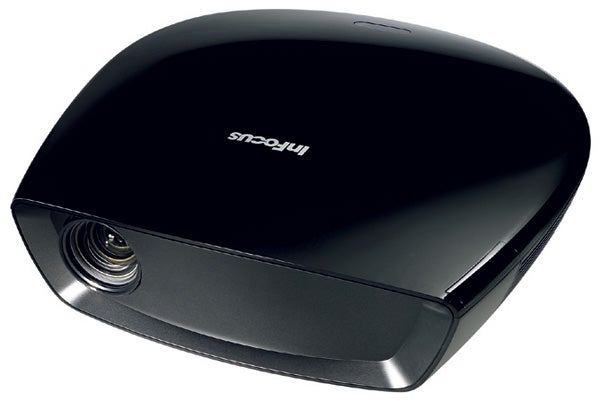
You can reduce the rainbow effect’s impact on the X10 by closing the iris to limit the image’s brightness, and personally I consider the issue a small price to pay for all the remarkable things the X10 gets right. But I know some people are more susceptible to the rainbow effect than others, so it’s definitely something you need to be aware of. Maybe you should try and get a demo of the unit before you buy, just to see if the rainbow effect is particularly bothersome for you.
A far less troubling issue is some extremely low-level grey pixel noise over very dark parts of the picture, though this is seldom if ever distracting. In fact, you might not even see it at all if you don’t go looking for it. Which of course you will now that I’ve mentioned it here. Sorry…
A final point would be that motion doesn’t look quite as fluid or crisp as we’d ideally like. But again, this is seldom a distracting issue, and I’m almost embarrassed I mentioned it at all given that we’re talking about a Full HD DLP projector costing under £900.
”’Verdict”’
If I had a pound for every time I’d used the phrase ‘you only get what you pay for’ in the course of my reviews for this website, I’d be a wealthy man by now. But thankfully very occasionally you stumble across a perspective-shifting product that’s the exception to the rule. And the X10 is just such a product – with knobs on. In fact, quite where the rest of the home projection industry goes from here is anyone’s guess.
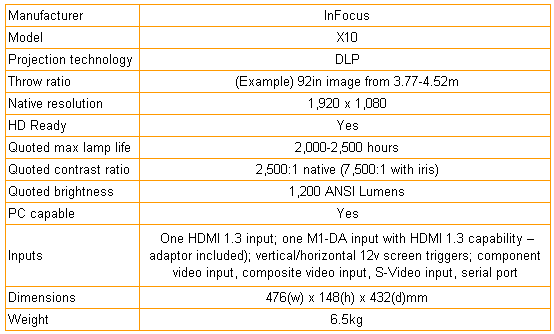
Trusted Score
Score in detail
-
Value 10
-
Features 8
-
Image Quality 8
-
Design 8
Features
| Native Aspect Ratio | 16:9 |
| Projector Type | DLP Projector |
| Brightness (Lumen) | 1200 lumenslm |
| Contrast Ratio | 2500:1 |
| Max Diagonal Image Size (Inch) | 203"in |
| Min Projection Distance (Foot) | 59"feet |
| Max Projection Distance (Foot) | 32.81 ftfeet |
| Lamp Type | UHP Lamp |
| Lamp power (Watt) | 300 W |

